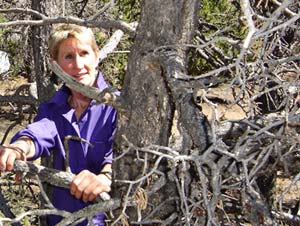|

Nancy Dahl kneels by a dead piñon tree. (Photo: Paul Ingles)

INGLES: It’s when one of Dunn’s probes picks up noises like these that he knows a tree is a goner.
[OCCASIONAL CLICKING OF BEETLE-INFESTED TREE]
DUNN: As soon as the beetles are present, then we hear this characteristic sound.
[MORE CLICKING OF INFESTED TREE]
DUNN: The sound of larvae and adult beetle motion. It’s a simple motion within the interior phloem of the tree.
[INFESTED TREE SOUNDS]
DUNN: And ips beetles, even though they’re very, very small, about the size of a small grain of rice, they have a little sound generating organ on the back of their head called a pars striden. And it essentially functions like a gyro, or a percussion instrument that has ridges on it. So they basically can rub this, their middle of their body, against their heads as they move the heads. And they produce sound both intentionally but also, I think, secondarily as just a consequence of motion within the tree.
INGLES: A piñon tree, stressed by lack of water, essentially calls the beetles in by emitting a pheromone that signals it’s too weak to fight. If a beetle started to bore into a healthy piñon, the tree would produce sap to fill the hole and force the beetle out. But without water there’s no sap, and soon the beetles are drilling and breeding and making more of a racket. Here’s Dunn’s recording of a moderately infested tree.
[FASTER CLICKING OF BEETLE-INFESTED TREE]
INGLES: And before long, it sounds like quite a party in a fully infested tree.
[LOTS OF CLICKING OF INFESTED TREE]
INGLES: Even at this stage the piñon may look healthy on the outside, but the beetles have sentenced it to death by spreading a black stain fungus on the inside that moves down through the tree’s root structure. There it may spread on its own to other adjacent trees, or the beetles may themselves take the fungus to the next tree. But looking at, say, three apparently healthy piñons side by side is a bit like trying to guess which shell has the pea under it in a shell game.
HARRILL: From the point of view of the property owner, you’d like to know whether a tree is infected first.
INGLES: Bob Harrill is one of two scientists with David Dunn’s non-profit organization, the Art and Science Laboratory. He’s a doctor of chemistry who’s worked in applied environmental science since the late 1960s. Like Dunn, Harrill likes connecting the worlds of art and science to solve practical environmental riddles like, in this case, which tree has the beetles.
HARRILL: We can go out, insert a probe, listen for the presence of the beetle and tell the property owner that this tree is, or this tree is not, infected. That can help them make the decisions on which ones to spray.
INGLES: And which ones to water, which can also strengthen the tree against the beetle attack. As word of David Dunn’s technique spreads, he’s been asked by more property owners to listen to their trees. He’s happy to help and gather new data, but he says he’s not trying to create a business opportunity. In fact, if clients insist on paying, he suggests a contribution to his non-profit, so he can afford to make even more recordings and design affordable tools to unearth what Bob Harrill thinks may be a rich field of study.
HARRILL: There’s been a great deal of research on what’s called the chemical ecology. How chemicals produced by a tree, for example, might attract a particular pest, like a beetle. But we need to explore more about how sound mechanisms might actually contribute to the interactions between insects and plants.
INGLES: Whether Harrill and Dunn’s work can find utility beyond helping individual property owners save a few trees is uncertain. But their work has some state officials intrigued. Forest Service agents are open to the possibility that there might be some future role in forest management for the noises David Dunn and Bob Harrill are gathering. For Living on Earth, I’m Paul Ingles, in Santa Fe.
| 
